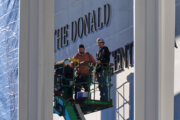WASHINGTON – A literally grave controversy has surrounded a high school being built in Prince William County.
To make way for the new school, an old cemetery was moved, and that didn’t go over well with the community.
The cemetery was discovered on the construction site late in the process. The school system followed the protocol in place at the time, and removed the remains to be reinterred elsewhere. But when the community found out, the school board took plenty of heat.
“We believe the remains that were discovered were the ancestors of the Lynn family,” says Marty Nohe, Prince William County supervisor of the Coles District, where the school is being built. The land was once owned by the Lynn family.
“They didn’t discover the cemetery until it was deep in the process and that didn’t allow for any meaningful community engagement before the decision was made to move the cemetery,” he says, adding, “I think we all wish we could go back and do things differently.”
Now school officials have decided to re-inter the remains close to the where they were found. Nohe says the silver lining is that tough lessons were learned, the most important being to make sure the community is included in the process.
And he says those lessons are already being applied to an old cemetery site across the street from the school, where a fire station will be expanded.
“Now we have an opportunity to do a much better job of engaging the family, engaging the community,” he says.
Cultural resource studies are required for private buildings, shopping centers and housing developments, but that review is not required for public buildings, according to Nohe.
But he suggests that needs to change.
“I think that there are opportunities to do a better job of discovering historical artifacts, things like cemeteries, prehistoric sites, whatever they are, prior to the construction of any public facility,” says Nohe.
But that has to begin with the county’s historical commission. The committee was established years ago by the Board of Supervisors to represent citizens on issues of historical and cultural resources.
In the case of the fire station, Nohe says, “We’ve already talked to them and engaged them in helping us do research about this cemetery.”
Nohe proposes that the historical commission be called in to study sites whenever publicly owned land includes a historic resource such as a cemetery, before any construction plans are finalized or approved by the board of supervisors.







